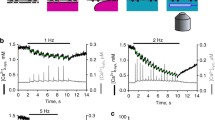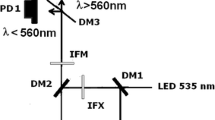Abstract
The role of inositol 1,4,5-trisphosphate [Ins(1,4,5)P 3] in excitation-contraction coupling in cardiac muscle is still unclear, although many laboratories are beginning to assume a critical role for this putative second messenger. Earlier studies from this laboratory [Nosek et al. (1986) Am J Physiol 250:C807] found that Ins(1,4,5)P 3 enhanced spontaneous Ca2+ release and the caffeine sensitivity of Ca2+ release from myocardial sarcoplasmic reticulum (SR) and proposed an increase in the Ca2+ sensitivity of the release as a possible mechanism. In order to clarify the phyisological relevance of these actions of Ins(1,4,5)P 3 and specifically to test the effect of Ins(1,4,5)P 3 on the Ca2+ sensitivity of Ca2+ release, we compared the effects of Ins(1,4,5)P 3 on Ca2+ oscillations and on Ca2+-induced Ca2+ release (CICR) from the SR in saponin-skinned rat papillary muscle. We found that: (a) 30 μM Ins(1,4,5)P 3 enhanced the Ca2+ oscillations (measured by tension oscillations) from the rat cardiac SR, consistent with the previous report on guinea pig tissue; (b) both GTP and GTP[S] enhanced Ca2+ oscillations. The effect was not additive to that of Ins(1,4,5)P 3 indicating that two different Ca2+-release pools do not exist in cardiac SR; (c) 30 μM Ins(1,4,5)P 3 had no effect on the Ca2+ sensitivity of CICR; (d) Ins(1,4,5)P 3 (up to 30 μM) had no effect on SR Ca2+ loading. The studies were performed in the presence of Cd2+ or 2,3-bisphosphoglycerate, agents that inhibit Ins(1,4,5)P 3 hydrolysis. These results suggest that: (a) two different mechanisms underlie Ca2+ oscillations and CICR, Ins(1,4,5)P 3 influencing Ca2+ oscillations but not CICR; (b) Ins(1,4,5)P 3 does not increase the Ca2+ sensitivity of Ca2+ release from the SR; (c) cardiac muscle is different from smooth muscle where Ca2+ release from the SR is dependent upon GTP; (d) the physiological role of Ins(1,4,5)P 3 in excitation-contraction coupling in cardiac muscle is minimal. In contrast, Ins(1,4,5)P 3 may play a pathological role in cardiac arrhythmogenesis by enhancing spontaneous Ca2+ ocsillations.
Similar content being viewed by others
References
Allen DG, Eisner DA, Pirolo JS, Smith GL (1985) The relationship between intracellular calcium and contraction in calcium-overloaded ferret papillary muscles. J Physiol (Lond) 364:169–182
Brown JH, Jones LG (1986) Phosphoinositol metabolism in the heart. In: Putney JW Jr (ed) Phosphoinositides and receptor mechanisms. Liss, NY, p 245
Capogrossi MC, Houser SR, Bahinski A, Lakatta ÉG (1987) Synchronous occurrence of spontaneous localized calcium release from the sarcoplasmic reticulum generates action potentials in rat cardiac ventricular myocytes at normal resting membrane potential. Circ Res 61:498–503
Donaldson SK, Goldberg ND, Walseth TF, Huetteman DA (1988) Voltage dependence of inositol 1,4,5-trisphosphate-induced Ca2+ release in peeled skeletal muscle fibers. Proc Natl Acad Sci USA 85:5749–5753
Ehrlich BE, Watras J (1988) Inositol 1,4,5-trisphosphate activates a channel from smooth muscle sarcoplasmic reticulum. Nature 336:583–586
Endo M, Iino M (1988) Measurement of Ca2+ release in skinned fibers from skeletal muscle. Methods Enzymol 157:12–25
Fabiato A (1985) Effects of ryanodine in skinned cardiac cells. Fed Proc 44:2970–2976
Fabiato A (1989) Appraisal of the physiological relevance of two hypotheses for the mechanism of calcium release from the mammalian cardiac sarcoplasmic reticulum: calcium-induced release versus charge-coupled release. Mol Cell Biochem 89:135–140
Fanó G, Belia S, Fulle S, Angelella P, Panara F, Marsili V, Pascolini R (1989) Functional aspects of calcium transport in sarcoplasmic reticulum vesicles derived from frog skeletal muscle treated with saponin. J Muscle Res Cell Motil 10:326–330
Furuichi T, Shiota C, Mikoshiba K (1990) Distribution of inositol 1,4,5-trisphosphate receptor mRNA in mouse tissues. FEBS Lett 267:85–88
Heathers GP, Evers AS, Corr PB (1989) Enhanced inositol trisphosphate response to α 1-adrenergic stimulation in cardiac myocytes exposed to hypoxia. J Clin Invest 83:1409–1413
Hirata M, Suematsu E, Hoshimoto T, Hamiachi T, Koga T (1984) Release of Ca2+ from a non-mitochondrial store site in peritoneal macrophages treated with saponin by inositol 1,4,5-trisphosphate. Biochem J 233:229–236
Kentish JC, Barsotti RJ, Lea TJ, Mulligan IP, Patel JR, Ferenczi MA (1990) Calcium release from cardiac sarcoplasmic reticulum induced by photorelease of calcium of Ins(1,4,5)P3. Am J Physiol 258:H610-H615
Kobayashi S, Somlyo AP, Somlyo AV (1988) Guanine nucleotide- and inositol 1,4,5-trisphosphate-induced calcium release in rabbit main pulmonary artery. J Physiol (Lond) 403:601–619
Kusuoka H, Porterfield JK, Weisman HF, Weisfeldt ML, Marban E (1987) Pathophysiology and pathogenesis of stunned myocardium. J Clin Invest 79:950–961
Lakatta EG, Capogrossi MC, Kort AA, Stern MD (1985) Spontaneous myocardial calcium oscillations: overview with emphasis on ryanodine and caffeine. Fed Proc 44:2977–2983
Meissner G, Henderson JS (1987) Rapid calcium release from cardiac sarcoplasmic reticulum vesicles is dependent on Ca2+ and is modulated by Mg2+, adenine nucleotide, and calmodulin. J Biol Chem 262:3065–3073
Mignery GA, Südhof TC, Takei K, De Camilli P (1989) Putative receptor for inositol 1,4,5-trisphosphate similar to ryanodine receptor. Nature 342:192–195
Nosek TM, Williams MF, Ziegler ST, Godt RE (1986) Inositol trisphosphate enhances calcium release in skinned cardiac and skeletal muscle. Am J Physiol 250:C807-C811
Otani H, Prasad MR, Engelman RM, Cordis GA, Das DK (1988) Enhanced phosphodiesterase breakdown and turnover of phosphoinositides during reperfusion of ischemic rat heart. Circ Res 63:930–936
Renard D, Poggioli J (1990) Mediation by GTP-γ-S and Ca2+ of inositol trisphosphate generation in rat heart membranes. J Mol Cell Cardiol 22:13–22
Saida K, Twort C, Van Breemen C (1988) The specific GTP requirement for inositol 1,4,5-trisphosphate-induced Ca2+ release from skinned vascular smooth muscle. J Cardiovasc Pharmacol 12 (Suppl 5):S47-S50
Vergara J, Tsien RY, Delay M (1985) Inositol 1,4,5-triphosphate: A possible chemical link in excitation-contraction coupling in muscle. Proc Natl Acad Sci USA 82:6352–6356
Vites A-M, Pappano A (1990) Inositol 1,4,5-trisphosphate releases intracellular Ca2+ in permeabilized chick atria. Am J Physiol 258:H1745-H1752
Volpe P, DiVirgilio F, Bruschi G, Regolisti G, Pozzan T (1989) Phosphoinositide metabolism and excitation-contraction coupling in smooth, cardiac and skeletal muscles. In: Michell RH, Drummond AH, Downes CP (eds) Inositol lipids in cell signalling. Academic Press, London, p 377
Author information
Authors and Affiliations
Rights and permissions
About this article
Cite this article
Zhu, Y., Nosek, T.M. Inositol trisphosphate enhances Ca2+ oscillations but not Ca2+-induced Ca2+ release from cardiac sarcoplasmic reticulum. Pflügers Archiv 418, 1–6 (1991). https://doi.org/10.1007/BF00370444
Received:
Revised:
Accepted:
Issue Date:
DOI: https://doi.org/10.1007/BF00370444




